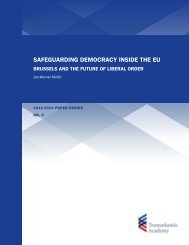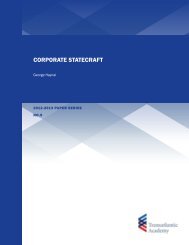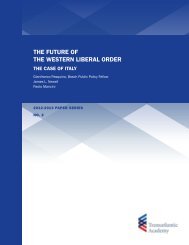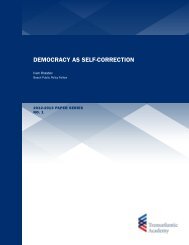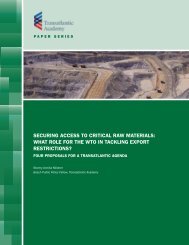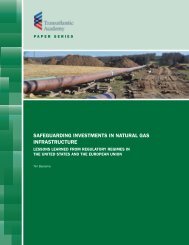the real g2: americans, europeans, and their role in the g20
the real g2: americans, europeans, and their role in the g20
the real g2: americans, europeans, and their role in the g20
- No tags were found...
Create successful ePaper yourself
Turn your PDF publications into a flip-book with our unique Google optimized e-Paper software.
The way <strong>the</strong>United States<strong>and</strong> <strong>the</strong> EU areimplement<strong>in</strong>g<strong>the</strong> G20 f<strong>in</strong>ancialmarket reformagenda islead<strong>in</strong>g to evenwider regulatorydiscrepanciesthan before<strong>the</strong> crisis.has also raised <strong>the</strong> degree of <strong>in</strong>terconnectedness– i.e. <strong>the</strong> level of market <strong>in</strong>tegration – between<strong>the</strong> two economic areas. As a result, <strong>the</strong>re isan <strong>in</strong>creas<strong>in</strong>gly strong rationale for enhanc<strong>in</strong>gcooperation on f<strong>in</strong>ancial regulation <strong>and</strong> oversight,as was acknowledged by <strong>the</strong> U.S. adm<strong>in</strong>istration<strong>and</strong> <strong>the</strong> EU Commission when <strong>the</strong>y issued <strong>the</strong>irJo<strong>in</strong>t Statement <strong>in</strong> 2008.If anyth<strong>in</strong>g, this rationale has been re<strong>in</strong>forced by<strong>the</strong> f<strong>in</strong>ancial crisis, which highlighted <strong>the</strong> grow<strong>in</strong>grisks of f<strong>in</strong>ancial contagion given <strong>the</strong> level ofcross-border capital flows already achieved. 14The implementation of <strong>the</strong> G20 agenda, however,gives rise to <strong>the</strong> concern that <strong>the</strong> regulatorydiscrepancies between <strong>the</strong> U.S. <strong>and</strong> <strong>the</strong> EU may,<strong>in</strong> fact, widen fur<strong>the</strong>r. This is likely to aggravate,ra<strong>the</strong>r than facilitate, <strong>the</strong> oversight of <strong>in</strong>creas<strong>in</strong>gly<strong>in</strong>ternationalized f<strong>in</strong>ancial markets between <strong>the</strong>United States <strong>and</strong> <strong>the</strong> EU as well as beyond. Notto mention <strong>the</strong> fact that substantial cost sav<strong>in</strong>gsfor corporate <strong>and</strong> retail clients from a more<strong>in</strong>tegrated f<strong>in</strong>ancial market will be lost. In case ofan <strong>in</strong>tegration of U.S.-EU securities markets alone,such sav<strong>in</strong>gs would be non-trivial <strong>and</strong> may amountto US$50 billion per year or more (see graph onpage 7). 15Look<strong>in</strong>g Ahead – The Role of <strong>the</strong>United States <strong>and</strong> Europe <strong>in</strong> <strong>the</strong> G20In f<strong>in</strong>ancial markets, <strong>the</strong> United States <strong>and</strong> <strong>the</strong> EUare <strong>the</strong> <strong>real</strong> G2. They carry a responsibility that goesfar beyond that of <strong>the</strong>ir partners <strong>in</strong> <strong>the</strong> G20: Theyrema<strong>in</strong> <strong>the</strong> largest <strong>and</strong> most advanced f<strong>in</strong>ancialmarkets worldwide. They look back at <strong>the</strong> mostextensive experience <strong>in</strong> f<strong>in</strong>ancial market regulation<strong>and</strong> supervision – not least ow<strong>in</strong>g to <strong>the</strong>ir <strong>role</strong> as<strong>the</strong> epicenters of <strong>the</strong> most severe f<strong>in</strong>ancial crises14TABD (2010).15For a quantification of <strong>the</strong> potential benefits of transatlanticsecurities market <strong>in</strong>tegration, see Steil (2002) <strong>and</strong> Kern(2010a).<strong>in</strong> history. And <strong>the</strong>y cont<strong>in</strong>ue to be <strong>the</strong> centre of<strong>in</strong>ternational f<strong>in</strong>anc<strong>in</strong>g <strong>and</strong> f<strong>in</strong>ancial <strong>in</strong>novation. At<strong>the</strong> same time, <strong>the</strong> benefits of achiev<strong>in</strong>g bilaterally<strong>and</strong> globally coord<strong>in</strong>ated reforms are evident.As a result, it seems advisable that <strong>the</strong> UnitedStates <strong>and</strong> <strong>the</strong> EU should be credible promoters<strong>and</strong> forceful drivers of f<strong>in</strong>ancial market policycoord<strong>in</strong>ation <strong>in</strong> <strong>the</strong> G20. Reach<strong>in</strong>g jo<strong>in</strong>t policypositions will, <strong>in</strong> practice, require concretecooperation on <strong>the</strong> schedul<strong>in</strong>g, design, <strong>and</strong> detailsof regulation. This would optimally <strong>in</strong>clude exante bilateral consultations on all new policymeasures <strong>in</strong> <strong>the</strong> area of f<strong>in</strong>ancial market regulationof national, bilateral, or <strong>in</strong>ternational dimensions,as well as a close coord<strong>in</strong>ation of policy positionsdiscussed <strong>in</strong> <strong>in</strong>ternational forums, especially <strong>in</strong><strong>the</strong> G20 <strong>and</strong> <strong>the</strong> bodies entrusted with support<strong>in</strong>gglobal f<strong>in</strong>ancial reform.F<strong>in</strong>ally, <strong>the</strong> credibility of Americans <strong>and</strong> Europeansas promoters of free capital flows <strong>and</strong> as key<strong>in</strong>novators <strong>in</strong> <strong>the</strong> global economy will depend<strong>in</strong> <strong>the</strong> long run on <strong>the</strong>ir ability to be good <strong>role</strong>models <strong>and</strong> achieve a more <strong>in</strong>tegrated f<strong>in</strong>ancialmarket at <strong>the</strong> transatlantic level. This would requiresystematic work on resolv<strong>in</strong>g exist<strong>in</strong>g bilateralregulatory barriers on <strong>the</strong> basis of <strong>the</strong>ir exist<strong>in</strong>gJo<strong>in</strong>t Statement, i.e. towards a harmonised <strong>and</strong>mutually recognized regulatory system. In o<strong>the</strong>rwords, <strong>the</strong>y will at some po<strong>in</strong>t need to embark on<strong>the</strong> journey towards a s<strong>in</strong>gle transatlantic f<strong>in</strong>ancialmarket.These are very ambitious objectives, <strong>and</strong> <strong>the</strong>ymay run counter to <strong>the</strong> zeitgeist that prevails <strong>in</strong><strong>the</strong> political environment after <strong>the</strong> economic <strong>and</strong>f<strong>in</strong>ancial crisis. But <strong>the</strong> benefits of <strong>in</strong>ternationallyconsistent f<strong>in</strong>ancial reform are substantial <strong>and</strong><strong>real</strong>, <strong>and</strong> no o<strong>the</strong>r two economies know thisbetter than those of <strong>the</strong> United States <strong>and</strong> <strong>the</strong> EU,whose prosperity is founded on <strong>the</strong> openness ofmarkets, <strong>the</strong> free flow of goods <strong>and</strong> <strong>in</strong>vestments,8Transatlantic Academy



